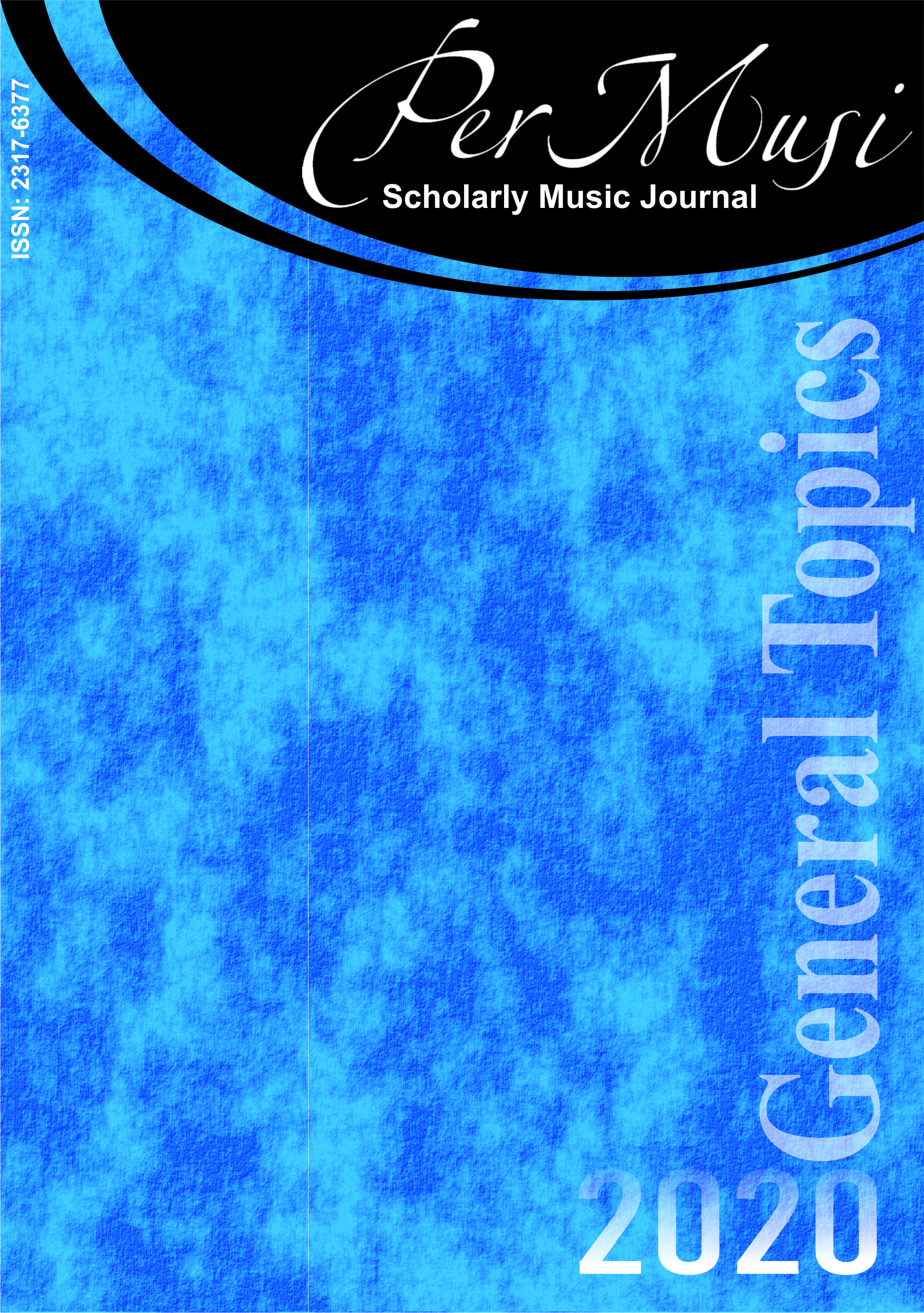Repertório para Sixxen
a (re)definição de um novo instrumento através da composição
DOI:
https://doi.org/10.35699/2317-6377.2020.5296Palavras-chave:
Iannis Xenakis, Pléïades, Sixxen, Repertório ContemporâneoResumo
O presente trabalho cataloga e discute o repertório composto entre 1978 e 2017 para Sixxen, instrumento criado por Iannis Xenakis. Para alcance dos resultados foi realizada ampla pesquisa bibliográfica e documental. Os resultados demonstram um repertório constituído por no mínimo 46 obras, de 43 compositores de 11 países. As décadas de 2000-2009 e 2010-2017 apresentam o maior quantitativo de obras (82% do total). A criação entre os anos de 2010-2015 em particular, com cerca de 70% do total de composições, supera o número total das décadas anteriores somadas e apresenta um incremento cinco vezes maior do que o quantitativo entre 2000-2009. A maior quantidade de composições é originária dos EUA, França e Brasil. O artigo também analisa informações sobre a notação para Sixxen, a relação de grupos com compositores para elaboração de novas obras e o redimensionamento conceitual e prático gerado pela aplicação do instrumento em diferentes contextos.
Referências
2. BATIGNE, Jean. Sur Persephassa et Pléïades. In: GERHARDS, Hugues (Org.). Regards sur Iannis Xenakis. Paris: Ed. Stock Musique, 1981. p.175-83.
3. BERNARD, Jean-Paul. Sixxen et Xenakis. [mensagem pessoal]. Mensagem recebida por ronangil@gmail.com em 30/03/2015.
4. CLOCKS IN MOTION. Memo to composers. s.d. Disponível em: <http://clocksinmotionpercussion.com/about/memo-to-composers/>. Acesso em: 20/03/2015.

5. COLEMAN, Matthew. Instrument Design in Selected Works for Solo Multiple Percussion. Tese de Doutorado. Arizona State University, Tempe, 2012.
6. FITCH, Fabrice. Brian Ferneyhough. London: Peters Edition Ltd., 2014.
7. GUILLOT, Matthieu. Monde et sons, écoute et inouï. In: SOLOMOS, Makis (Org.). Présences de Iannis Xenakis.
Paris: CDMC, 2001. p113-116.
8. HARLEY, James. Xenakis: His Life in Music. Nova York: Ed. Routledge, 2004.
9. LACROIX, Marie-Hortense. Pléïades de Yannis Xenakis. Musique et analyse. Paris: Ed. TUM - Michel de Maule, 2001.
10. MARANDOLA, Fabrice. Of Paradigms and Drums: Analysing and Performing Peaux from Pléïades. In:
KANACH, Sharon (Org.). Xenakis Matters. Nova York: Pendragon Press, 2012. p.185-204.
11. MES PERCUSSIONS. Sixxen. 18/09/2004. Disponível em: < http://mespercussions.pagesperso-
orange.fr/Instruments/sixxen.htm >. Acesso em: 05/05/2016.
12. MORAIS, R. G. de, CHAIB, F. M. de C., OLIVEIRA, F. F. de. Considerações históricas, estruturais e
características sobre o instrumento Sixxen, de Iannis Xenakis. Per Musi. 2017.
13. PARTCH, Harry. Genesis of a music. 2ed. Nova York: Da Capo Press, 1974.
14. REED, Brett. Building a Set of Sixxen. Percussive notes, v. 41, n. 3, p. 48-50, 2003.
15. YOKEN, David. Interview with Iannis Xenakis. Percussive Notes, v. 28, n. 3, p. 53-58, 1990.
Referências de Partitura
01. XENAKIS, Iannis. PLÉÏADES. Paris: Ed. Salabert, 1978.
02. ________. Idmen A et B. s.d. Disponível em: < http://www.iannis-xenakis.org >. Acesso em: 15/03/2015
Downloads
Publicado
Edição
Seção
Licença
Copyright (c) 2021 Per Musi

Este trabalho está licenciado sob uma licença Creative Commons Attribution 4.0 International License.

Exceto onde está indicado, o conteúdo neste site está sob uma Licença Creative Commons - Atribuição 4.0 Internacional.












